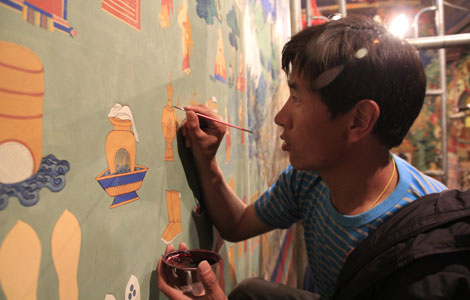When luxury meets history
Updated: 2013-07-24 13:10
By Fan Zhen (China Daily)
|
|||||||||||
In historic Tianjin’s old British Concession, a hotel has proudly stood by the banks of the Haihe River for one and a half centuries, and if its walls could talk, they would bring many legends to life. Fan Zhen reports.
Old architecture fascinates because they embody irrevocable time, and while human memory fades they stand testament to the great events and personalities that had inhabited their space. The Astor Hotel Tianjin, built by Methodist missionary John Innocent in 1863, is a classic example.
The 150-year-old landmark, now part of the Starwood hotel and resort management group’s Luxury Collection, has been restored to its full glory after an 18-month makeover by award-winning designer Alexandra Champalimaud.
The hotel was listed as a national cultural heritage site in 1996, and it curates its own museum, the only hospitality establishment in China to do so.
Sparkling chandeliers and polished wooden floors complement the patina that time has given the hotel, and the Astor has the great good fortune in having faithful employees who had lovingly preserved the little artifacts of time that help make it what it is – including the original menus from its first years.
For its two-week celebrations of its 150th birthday, The Astor actually replicated these historic menus for a dinner in its magnificent ballroom, including a dish most often ordered by the last emperor of China, Puyi and his empress, Wan Rong.
The displaced couple was only two among the hotel’s list of impressive guests.
In 1899, Herbert Hoover came to Tianjin to work for the Kailuan Coal mining company and stayed at The Astor Hotel. That was before he eventually became the 31st president of the United States.
China’s founding father Sun Yat-sen arrived in Tianjin by ship from the south and stayed here in 1912. The 10th Panchen Lama and the 14th Dalai Lama read their prayers here while visiting Tianjin in 1954. Revolutionaries Huang Xing and Liang Qichao were all guests.
The Astor was also a place of romance.
One of Tianjin’s most famous residents, the "Young Marshall" Zhang Xueliang, met his future wife Edith Chao here at the Astor. They fell in love and continued their legendary romance at the hotel, enjoying tea, dinners and dances.
The Astor was also where the revolutionary warlord Cai E conducted romantic rendezvous with the beautiful courtesan Xiao Fengxian.
Champalimaud has done an excellent job marrying past with present, and the designer’s use of colors and textures brings us back to an age where luxury was in the details.
Strategically placed mirrors at the end of long corridors prolong the walk and create the illusion that we are travelling in a time warp.
In the old wing of the hotel, the scent of wood polish drifts up from the original timber floor and crimson carpets, old oils on the wall, vintage pendant lamps on wall scones and ancient telephones add to the film-set scenario.
The Astor was a leader in using modern technology.
It has the first elevator in Tianjin, installed by the American company Otis in 1924, right next to the entrance of its current museum in the basement. The metal cages are meticulously polished, but it is no longer in regular use.
Mei Lanfang, China’s original diva of Beijing opera, was one of the few who used it when he stayed at the Astor.
Situated in the port city of Tianjin, the hotel had the advantage of being the first to try new imports from the West.
With the help of Li Hongzhang, the viceroy and chief diplomat of the late Qing dynasty, cable communication was set up here and the Astor became the first hotel in China to have telephones in 1877.
It was also the first in Tianjin to have running water and regulated central heating.
Sepia prints of illustrious visitors from the past are part of the décor, and they range from presidents and generals to business tycoons and socialites to revolutionaries and the cultural elite.
The rooms where they once stayed are named after them, and commemorated with copper plates just outside the doors of these suites in the heritage Astor Wing.
The renovation and refurbishment of the hotel took a lot of time, and effort, according to Christian Metzner, the general manager.
"One of the main tasks was to actually refurbish the hotel based on old pictures because in the last 50 years, a lot had changed," Metzner says. The hotel came under Japanese occupation during the Second World War.
Staying at The Astor in Tianjin is like a trip back in time to a much more gracious age, where you can forget the crowds and the frantic urban lifestyle and indulge in a place where time seems to have slowed almost to a standstill. It is a gem of a retreat, a place where you can revel in luxury, and look back on history.
And we can fully understand why it is on the list of national heritages.
Contact the writer at fanzhen@chinadaily.com.cn.
Related Stories
Wedding fair displays latest trends at Shangri-la hotel 2013-04-07 17:13
Hotel listing: Shanghai 2012-12-31 15:58
Hotel listings in Beijing: Christmas and new year 2012-12-22 19:33
Hotels.com Welcome Rewards Celebrates One Year Anniversary 2012-12-19 17:41
More luxury hotels take shark fin off their menu 2012-12-18 09:23
Today's Top News
China warily eyes Japan's SE Asia buying binge
Financial guru looks to nation's future
Officers suspended after alleged beating
Mental health care falls short
Deliveries up as mercury rises
Audit targets local government debt
Xi's speech underlines commitment to reform
Brain drain may be world's worst
Hot Topics
Lunar probe , China growth forecasts, Emission rules get tougher, China seen through 'colored lens', International board,
Editor's Picks

|

|

|

|

|

|





